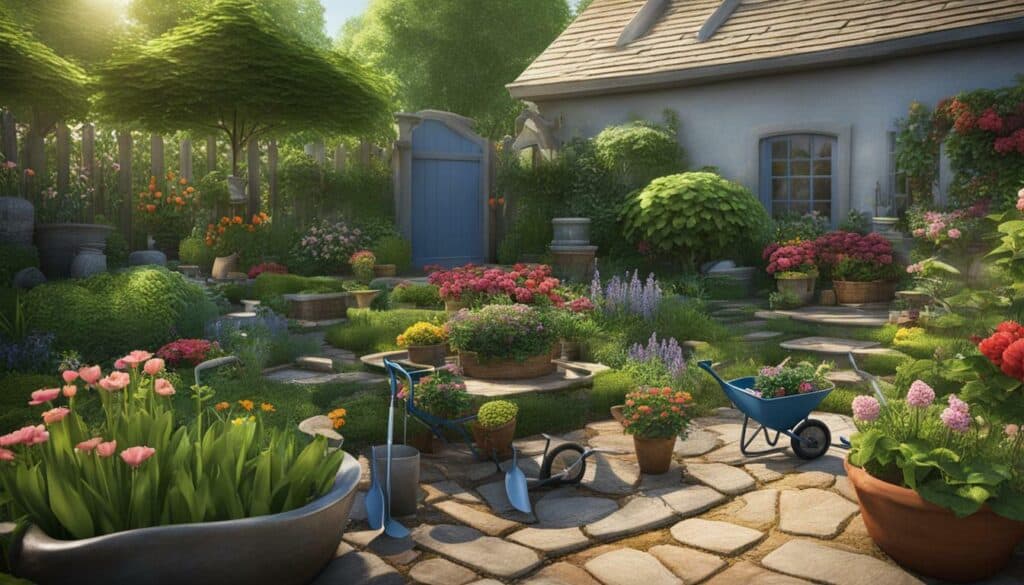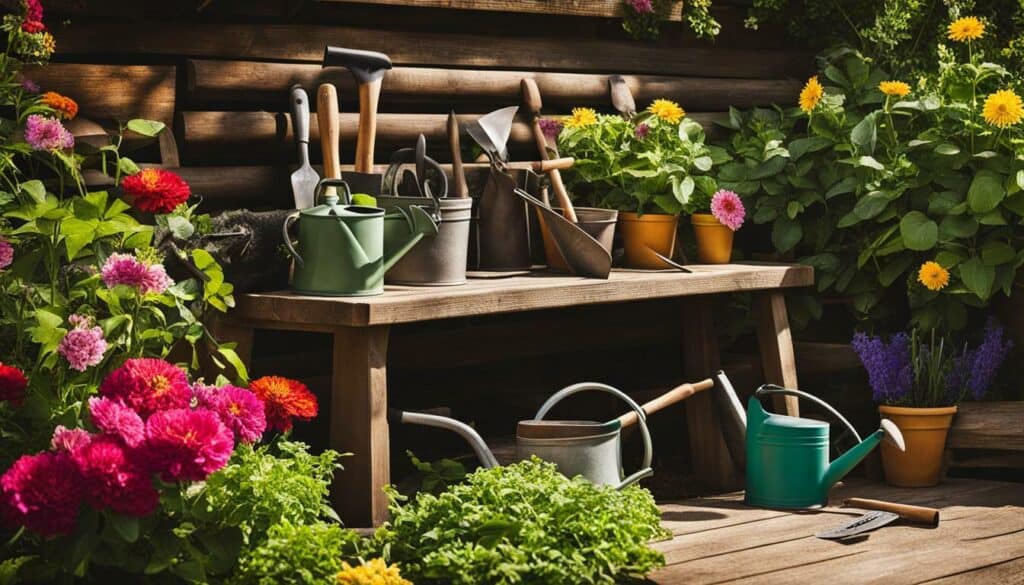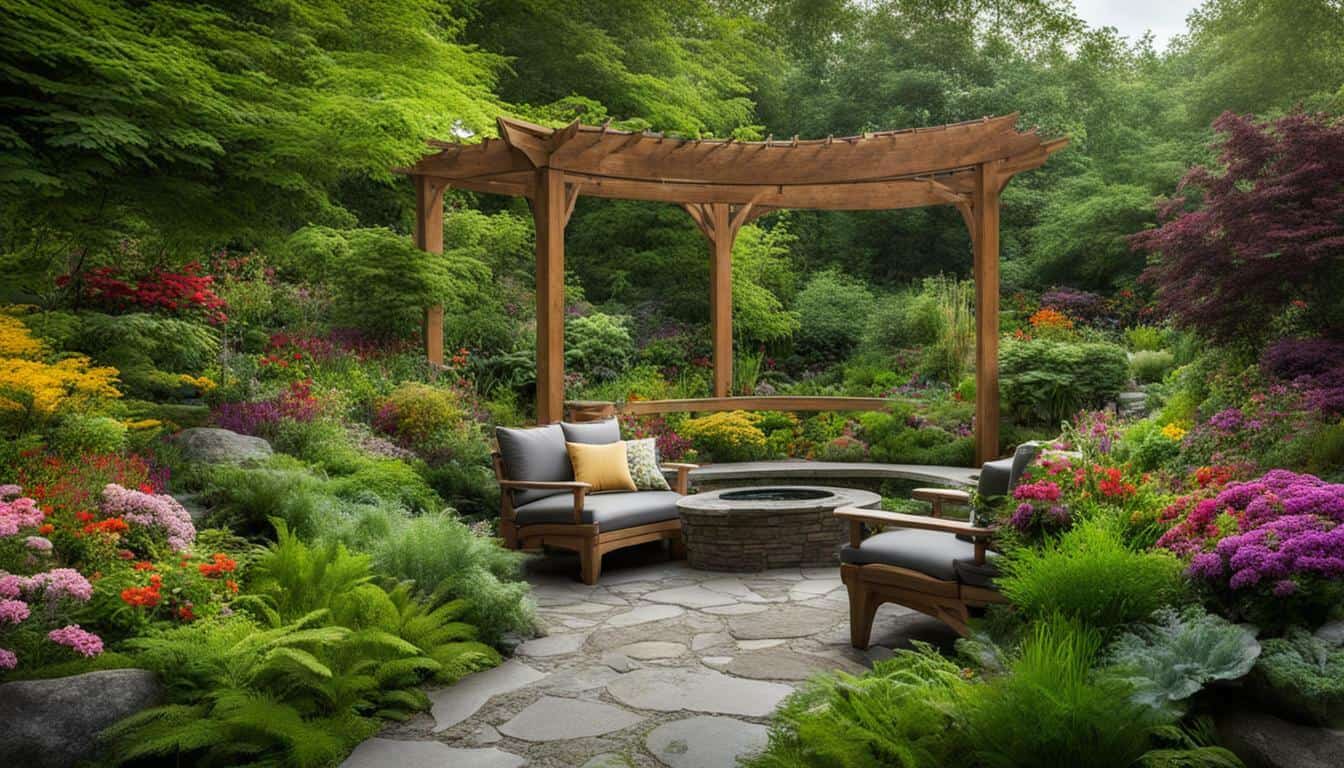Welcome to the enchanting world of gardens, where nature’s captivating beauty unfolds through an array of vibrant garden plants. Kids and adults alike can find wonder and delight in transforming their garden into an engaging and interactive space. By incorporating various elements, such as hidden nooks, kid-friendly elements, and hands-on gardening projects, a garden can become a place of magic and exploration. Starting with creating places to discover, like a pathway that leads to a secret garden, or adding a swing or hammock to the outdoor dining area, these simple touches can enhance the garden experience for all.
Engaging kids in the magic of growing plants from seeds is another way to spark their interest in the outdoors. Starting a vegetable garden or growing herbs indoors can involve children in every step of the process, from choosing seeds to planting and harvesting. By taking ownership of a certain garden project, like creating plant labels or watering a raised bed, children can develop valuable gardening skills and feel a sense of pride in their contribution to the garden.
Creating a garden that attracts wildlife is not only beneficial for the environment but also provides an opportunity for children to observe and learn about different species. By adding bird feeders, birdbaths, and pollinator-friendly flowers, kids can learn about the birds, butterflies, and insects that share the garden space. In addition to wildlife, the garden can be transformed into multiple outdoor rooms, with different areas for various activities such as outdoor kitchens, play spaces, and relaxation areas.
Beyond the backyard, there are also many beautiful gardens around the world to explore. From the Ruth Bancroft Garden in San Francisco and Medellín Botanical Garden in Colombia, to the Dubai Miracle Garden and Humble Administrator’s Garden in China, these gardens offer breathtaking displays of nature’s wonders. Whether it’s the diverse collection of succulents in San Francisco or the extensive orchid collection in Medellín, these gardens provide an opportunity to immerse oneself in the beauty of nature.
Key Takeaways:
- Transform your garden into an engaging space with hidden nooks, kid-friendly elements, and hands-on gardening projects.
- Involve children in the gardening process to spark their interest in the outdoors and develop valuable skills.
- Create a garden that attracts wildlife for environmental and educational purposes.
- Explore stunning gardens around the world for breathtaking displays of nature’s wonders.
Creating Engaging Gardens for All Ages
Discover the joy of creating gardens that captivate and inspire, engaging both young and old with their unique design and imaginative ideas. When it comes to designing a garden, the key is to create an outdoor space that appeals to all ages. For kids, this may mean incorporating interactive elements such as hidden nooks, kid-friendly areas within adult spaces, and unique play areas. For adults, it may mean creating a calming atmosphere with serene seating areas and water features, or adding some excitement with vibrant colors and bold plant choices.
Starting a vegetable garden can be a fun way to get kids interested in the outdoors and promote healthy eating. Involving them in the planting and harvesting process can encourage their sense of responsibility and teach them about the life cycle of plants. Why not plant some fruit trees for kids to pick their own snacks or provide bird feeders and insectaries to welcome wildlife into your garden? Personalizing the garden and allowing children to take ownership over certain projects, such as planting their own flowers or vegetables, can further engage them and develop a sense of pride in their work.
Observing, reflecting, and learning from the garden can be enhanced with journals, drawings, and photos. Encourage children to keep a garden journal, where they can note the changes they see in their plants over time or draw pictures of the wildlife they spot. Sharing the garden with others and gardening together as a family can foster a sense of pride and enjoyment. By working together on a project, families can bond, teach responsibility, and create lasting memories.
Finally, consider certifying your garden as a wildlife habitat to provide a sense of accomplishment and contribute to conservation efforts. The process involves meeting a set of criteria for providing food, water, and shelter for wildlife. It’s a great way to showcase your garden’s beauty and sustainability while positively impacting the environment.
Gardening with Kids: Growing Green Thumbs
Nurture a love for gardening in children by involving them in the process of planting and growing their own delicious vegetables. Gardening with kids is a great way to engage them in the outdoors and foster a love for nature. Here are some ideas to create a garden that will capture their imagination and encourage their interest in gardening:
- Create hidden nooks and secret hideaways in the garden to make it more interesting and engaging for kids.
- Incorporate kid-friendly elements like swings or hammocks near adult areas to give kids something to do while adults relax.
- Introduce kids to the magic of seed-starting by having them help with filling seed trays, planting seeds, and watching them grow.
- Involve kids in every step of starting a vegetable garden, from choosing seeds to planting, weeding, and harvesting. To make it fun, let them play with dirt and water.
- Give kids their own garden project, such as creating plant labels or taking care of a raised bed. This helps them learn responsibility and ownership.
- Plant fruits and berries that kids can pick themselves, like strawberries and blackberries, to encourage them to spend more time outdoors.
- Build a bean teepee for kids to play in and grow climbing plants around it. This makes gardening fun and interactive.
- Use willow branches to create a leafy hideaway or fort for kids to play in. This fosters creativity and imagination.
- Create a natural play space using materials like branches and bamboo stakes instead of traditional hardscape structures. This promotes eco-friendliness and sustainability.
- Teach kids about wildlife by putting out bird feeders, adding nectar to hummingbird feeders, and planting pollinator-friendly flowers. This helps them understand the importance of nature.
- Divide the garden into multiple outdoor rooms to make it more dynamic and interesting for both kids and adults. This can include herb gardens, sensory gardens, and butterfly gardens to create a fun learning environment.
By involving kids in gardening and creating a space that engages their senses and imagination, you can help them develop a love for nature and grow their green thumbs. Remember to make it fun, make it messy, and let them get their hands dirty!

Creating Magical Hideaways in the Garden
Transform your garden into a whimsical paradise by incorporating a variety of colorful flowers that bring vibrancy and magic to its every nook and cranny. By adding a touch of creativity and imagination, you can create enchanting hideaways that capture the hearts of both kids and adults alike.
One way to create a magical hideaway is by concealing areas of your garden to create an enticing destination. Use trellises, hedges, or tall plants to create a secret space where people can escape and relax. This is especially popular with kids, who love to explore new and exciting areas, especially if they are hidden away and secret.
Another great idea is to add kid-friendly elements like swings or hammocks to grown-up areas. This not only incorporates fun elements into the garden but also creates a space where the whole family can spend time together and make memories that last a lifetime.
Similarly, involving children in the magic of growing plants from seeds can be a great way to create a sense of ownership and pride over their garden hideaway. Starting a vegetable garden, creating a natural jungle gym, and welcoming wildlife are all great ways to enhance the magical atmosphere of the garden.

By personalizing the garden and observing and reflecting on the wildlife that visits, children can develop a deeper appreciation for the natural world and their place in it. Sharing the space with others, including family and friends, can also be a great way to build connections and make the garden an even more magical place.
Gardening together as a family can be a fun and educational experience that creates lasting memories. Adults can make gardening with kids enjoyable by following some tips and guidelines, such as keeping tools and equipment child-friendly and encouraging them to get hands-on and dirty.
By fulfilling certain habitat elements, your garden can even be certified as a National Wildlife Federation Certified Wildlife Habitat®, further highlighting its magical qualities. With a bit of creativity, imagination, and effort, your garden can become a sanctuary of beauty, learning, and connection.
Welcoming Wildlife into the Garden
Embrace nature’s harmony by welcoming an array of wildlife into your garden, from birds and butterflies to beneficial insects, through proper garden maintenance and essential elements. By creating places for discovery and incorporating kid-friendly elements, you can engage children with the outdoors and spark a lasting interest in wildlife.
Starting seeds and growing a vegetable garden are excellent ways to get children involved in gardening. Giving them their own garden project is also a great idea, as it provides a sense of ownership and responsibility. Planting trees and bushes that produce fruits and berries can attract wildlife like birds and butterflies. Building bean teepees, hiding places out of willow branches, and natural jungle gyms provide interactive spaces for kids to play and explore, while also attracting and supporting diverse wildlife.
Teaching children about the wild creatures that inhabit gardens and creating multiple outdoor rooms can further enhance their connection with nature. Ensure your garden provides food, water, and shelter for wildlife by maintaining it regularly and adding essential elements like bird feeders, birdbaths, and insect hotels. By welcoming wildlife into your garden, you can not only benefit the environment but also foster a love for the natural world in children.

Incorporating these tips into your garden routine can make it an engaging and educational space for the whole family. Gardening with children can empower them with empathy and responsibility as they learn about the ecosystem and their impact on the environment. By creating a welcoming environment for wildlife, we can cultivate a deeper connection to the natural world and work towards a sustainable future.
Exploring Gardens Around the World
Embark on a global journey through breathtaking gardens around the world, each offering a distinctive design and a wealth of ideas to inspire your own garden paradise.
From the Ruth Bancroft Garden in San Francisco to the Medellín Botanical Garden in Colombia, exploring gardens around the world provides a wonderful opportunity to engage and delight kids and adults alike.
The Singapore Botanic Gardens, with its impressive collection of flowering plants, serves as a leading tropical botanical institute. Its diverse flora and fauna inspire creativity and wonder, offering visitors a chance to learn about the natural world.
Incorporating these designs and ideas from around the world into your garden can make it unique and magical. For example, creating hidden nooks and play spaces in the garden adds an element of mystery and makes the garden more interesting. Personalizing the garden with artwork and creating natural play spaces can further enhance the experience.
Starting seeds and growing a vegetable garden is a simple yet awe-inspiring activity that can teach kids about the magic of nature and encourage them to eat their veggies. Involving children in specific garden projects, such as creating plant labels or watering raised beds, helps them feel a sense of ownership and learn valuable gardening skills. Additionally, planting fruit trees and berries in the garden can entice children to spend more time outdoors.
By creating a garden for wildlife, children can make a positive impact on the environment and learn about different species of animals. Engaging the senses through fragrant plants, textured foliage, and a water feature adds to the appeal for both children and wildlife. Regular observation and reflection, accompanied by journaling or drawing, can reinforce learning and foster a sense of connection to the natural world.
Exploring gardens worldwide provides inspiration and ideas for design, and there are numerous resources available online and in magazines to help plan and create a unique garden experience. Sharing the garden with others, giving tours to friends and family, boosts a child’s sense of accomplishment and pride. Gardening as a family activity creates lasting memories and encourages a love of nature.
One can also seek certification from the National Wildlife Federation as a Certified Wildlife Habitat®, ensuring the garden meets all the necessary criteria for supporting wildlife.
Gardening with Kids: Growing Green Thumbs
Cultivate a sense of wonder and discovery in children by utilizing gardens as outdoor classrooms, where they can explore and connect with the fascinating world of plants and vegetables. Growing a vegetable garden is an excellent way to allow kids to witness the magic of plant growth and learn essential gardening skills. Starting seeds indoors and transplanting them outdoors provides a hands-on learning experience. Kids can also learn about companion planting and crop rotation, which promotes healthy soil and plant growth. Growing fruit trees and berries in the garden provides a sweet incentive for kids to spend time outdoors and learn about the importance of pollinators in the ecosystem.
Building structures like a bean teepee or a leafy fort using natural materials promotes creativity and imaginative play. Kids can design and build their own outdoor hideaways using branches, sticks, and leaves. Incorporating kid-friendly elements such as swings and hammocks provides opportunities for relaxation and a break from gardening tasks.
Teaching children about the different species in the garden and welcoming wildlife encourages a connection to nature. Kids can observe and document the insects, birds, and small animals that visit the garden. They can learn about the importance of providing habitats and food sources for wildlife and how to create a wildlife-friendly garden.
Dividing the garden into multiple outdoor rooms caters to different activities, such as a vegetable garden, a sensory garden, and a wildlife garden. Each room is designed to engage the senses and provide a unique learning opportunity.
Visiting botanical gardens and exploring different landscapes can inspire garden design ideas. Children can learn about different plants, garden design, and sustainability practices. Involving children in the creation and maintenance of the garden gives them a sense of ownership and pride. Observing, reflecting, and documenting their experiences in the garden enhances their learning and provides a record of their progress.
Sharing the garden with others and giving tours builds confidence and a sense of community. Gardening together as a family fosters bonding and creates lasting memories. Certifying the garden as a wildlife habitat promotes environmental stewardship and encourages sustainable practices.

Conclusion
Cultivating learning and connection in the garden provides a valuable and engaging experience for both kids and adults. Gardening with kids is a fun and educational activity that promotes a connection to nature and encourages environmental stewardship. A well-designed garden can provide a sanctuary for relaxation, play, and learning. By fostering a love for gardening and the natural world, we can inspire the next generation of green thumbs.
Gardening Together: A Family Affair
Strengthen family bonds and create lasting memories by engaging in the delightful journey of gardening together, equipped with essential tools and an eagerness to nurture and grow.
Gardening can be a fun and educational activity for the whole family. By creating a garden that engages and delights kids and adults, you can foster a deep interest in the outdoors.
| Ideas to get started |
|---|
| Create hidden nooks and secret hideaways in the garden to make it more interesting and enticing for kids. |
| Incorporate kid-friendly elements like swings or hammocks near adult areas to keep kids entertained. |
| Get kids involved in starting seeds by having them help fill seed trays, poke holes, and plant seeds. Opt for larger seeds like sunflowers and pumpkins that are easy for small hands. |
| Invite kids to be part of planting and maintaining a vegetable garden. Let them choose their favorite vegetables or herbs to grow, and involve them in planting, weeding, watering, and harvesting. |
| Assign kids a specific garden project, such as creating plant labels or taking care of a small raised bed. This will give them a sense of ownership and teach them valuable gardening skills. |
| Plant fruit trees, berries, and other kid favorites in the garden to encourage children to spend more time outdoors and learn about where their food comes from. |
| Build a bean teepee that acts as a trellis for vines and a play space for children. |
| Use willow branches to create a leafy hideaway or fort for kids to play in. |
| Design natural play spaces using materials like branches or cut bamboo for children to construct their own forts or structures. |
| Teach children about wildlife by putting out bird feeders, adding nectar to hummingbird feeders, and planting pollinator-friendly flowers. |
| Divide the garden into multiple outdoor rooms to create dynamic spaces that appeal to both kids and adults. |
By following these ideas and getting everyone involved, gardening can become a family affair that fosters a love for nature and the outdoors. To maintain your family garden, essential garden tools such as shovels, hoes, gloves, and watering cans will come in handy. Regular garden maintenance is important for enjoying the garden to the fullest and keeping it in top shape.

Enjoy the journey of gardening with your loved ones and create a peaceful sanctuary filled with beauty and laughter.
Supporting the Environment: Certifying Your Garden
Take a step towards supporting the environment by certifying your garden as a wildlife habitat, ensuring its role in preserving biodiversity and fostering a sustainable ecosystem. Creating a certified wildlife habitat is an easy and rewarding process, involving simple changes to the garden that support the local ecosystem.
Start by providing the necessary elements for wildlife, such as food, water, shelter, and places to raise young. Incorporate native plants, shrubs, and trees that are adapted to the local climate, and avoid using pesticides or chemical fertilizers that can harm wildlife. Growing a vegetable garden and creating natural play spaces are also important elements to include.
Teaching children about wildlife and providing designated spots for observation can connect them to the natural world. Personalizing the garden and engaging the senses with fragrant and colorful plants, grasses, and water features can attract wildlife, creating a thriving and diverse ecosystem.
By observing, reflecting, and sharing the garden with others, children can reinforce their ownership and pride. Finally, you can certify your garden as a National Wildlife Federation Certified Wildlife Habitat® by ensuring that all necessary habitat elements are included and filling out the required application.
Certifying your garden as a wildlife habitat not only benefits your local ecosystem but also provides a sense of accomplishment and purpose for all involved. Join the millions of Americans who have already certified their gardens and contribute to the preservation of our natural world.

Conclusion
In the world of gardens, endless wonders await, from the vibrant blooms and lush foliage to the joyous laughter and discoveries they inspire. Creating a garden that engages and delights both kids and adults is a rewarding endeavor. By incorporating kid-friendly elements and involving children in the process of planting and maintaining a garden, you can spark a deep, long-lasting interest in the outdoors.
By growing plants from seeds, starting a vegetable garden, and creating unique features like a bean teepee or a leafy hideaway, children can take ownership of their garden projects and learn valuable gardening skills. Plants like trees that produce fruits, berries, and other kid favorites can entice children to spend more time outdoors.
Welcoming wildlife, creating multiple outdoor rooms, and exploring different types of gardens around the world can further enhance the garden experience for both children and adults. By engaging all the senses, observing and reflecting on the garden, and sharing the garden with others, children can develop a sense of pride and connection to the natural world.
Certification for Wildlife Habitat
Lastly, by certifying the garden as a wildlife habitat, you can provide further educational opportunities and contribute to the conservation of wildlife. Gardening with children can be a fun and educational experience that fosters a love for nature and the environment.
FAQ
Q: What can I do to make my garden more engaging for both kids and adults?
A: You can incorporate interactive elements like hidden nooks, swings, and hammocks. This will make the garden more interesting for everyone.
Q: How can I get kids involved in gardening?
A: You can start by getting them interested in gardening by starting seeds and growing a vegetable garden. You can also assign them specific garden projects to encourage ownership.
Q: What can I do to welcome wildlife into my garden?
A: To welcome wildlife, you can provide food, water, and shelter for them. Creating multiple outdoor rooms and planting fruit trees can also attract different types of wildlife.
Q: Can you recommend any gardens around the world that I can explore?
A: Sure! You can explore gardens like the Ruth Bancroft Garden in San Francisco and the Singapore Botanic Gardens for inspiration.
Q: How can gardening help children learn and connect with nature?
A: Gardening provides educational opportunities for children. It engages their senses, encourages observation and reflection, and fosters curiosity and learning about the natural world.
Q: Is gardening a good activity for families to do together?
A: Absolutely! Gardening as a family activity promotes bonding, teaches responsibility, and allows for quality time spent together. It’s a fun and rewarding experience for everyone.
Q: How can I support the environment through my garden?
A: You can support the environment by certifying your garden as a wildlife habitat. This promotes environmental sustainability and conservation.
What Benefits Can I Expect from Cultivating Green Spaces in My House?
What benefits can I expect from cultivating green spaces in my house? Gardening indoors made easy brings numerous advantages. Firstly, it enhances air quality by removing toxins and increasing oxygen levels. Secondly, it improves mental well-being, reducing stress and promoting relaxation. Moreover, indoor plants can boost productivity and creativity while adding beauty to your home decor.
Source Links
- https://www.veranda.com/travel/g28325127/most-beautiful-gardens-in-the-world/
- https://www.houzz.com/magazine/spark-wonder-in-the-garden-with-these-family-friendly-ideas-stsetivw-vs~88485493
- https://www.nwf.org/Garden-for-Wildlife/Create/At-Home/Kids-Garden-for-Wildlife
- https://kidsgardening.org/resources/garden-activities-garden-age/
- https://www.betterhealth.vic.gov.au/health/healthyliving/gardens-for-all-a-health-activity
- https://www.betterhealth.vic.gov.au/health/healthyliving/gardening-for-children
- https://squarefootgardening.org/2023/06/growing-green-thumbs/
- https://www.doinggoodtogether.org/bhf/blog/little-green-thumbs
- https://www.orbitonline.com/blogs/learn-and-grow/growing-green-thumbs-a-guide-to-starting-a-school-garden-or-garden-club
- https://southernlivingplants.com/plan-your-garden/5-steps-to-create-your-secret-garden/
- https://ngb.org/garden-hangouts-and-hideaways-for-kids/
- https://www.hgtv.com/outdoors/gardens/garden-styles-and-types/create-a-secret-garden
- https://growingfamily.co.uk/garden-tips/how-to-garden-for-wildlife-50-easy-ways-to-make-your-garden-wildlife-friendly/
- https://www.discoverwildlife.com/how-to/wildlife-gardening/how-to-start-a-wildlife-garden/
- https://www.nhm.ac.uk/discover/seven-ways-to-create-a-wildlife-friendly-garden.html
- https://sandinmysuitcase.com/beautiful-gardens-in-the-world/
- https://mymodernmet.com/famous-gardens-around-the-world/
- https://njaes.rutgers.edu/fs1211/
- https://kidsgardening.org/resources/create-sustain-a-program-connecting-the-garden-to-the-classroom-2/
- https://redeemyourground.com/home-garden-father-son/
- https://emergewomanmagazine.com/cultivating-bonds-making-gardening-a-family-affair/
- https://harddy.com/blogs/how-to-guides/the-benefits-and-importance-of-gardening-with-your-family
- https://www.nwf.org/CERTIFY
- https://chirpforbirds.com/miscellaneous/how-to-turn-your-garden-or-yard-into-a-certified-wildlife-habitat/
- https://extension.psu.edu/certify-your-garden-as-pollinator-wildlife-friendly
- https://growingourown.wordpress.com/6-conclusion/
- http://lizfabry.blogspot.com/2012/11/garden-update.html?m=1
- https://www.daleharvey.com/in-the-garden/articles-of-interest/PACIFIC STEEL SUTTON PARK/Sutton Park Primary School Gardening Project/Page 5 – Conclusion.html





Leave a Reply